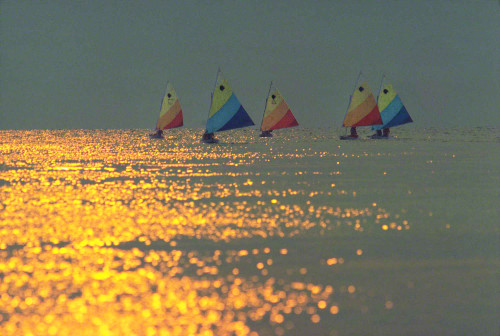In my online class with the BPSOP, and in my “Stretching Your Frame of Mind” workshops I conduct around the planet, we work on incorporating the Elements of Visual Design into our photography. One of the basic elements is Shape.
Shapes are all around us and whether the viewer knows it or not, he’ll see them and react. Used in our imagery, shapes will provide a sense of structure and unity to your composition. The four basic shapes are: circles, squares, rectangles, and triangles. These shapes when all the sides are the same are perceived by the viewer as systematic, stable, and symmetrical. The shapes that are similar but are more irregular such as an isosceles triangle or a trapezoid have more energy. Besides those that are more prevalent in our world, the diamond is a great shape, filled with a great deal of energy and evokes a sense of motion; not to be overlooked. Repeating these shapes will provide a sense of unity, and can be perceived by the viewer as one group.
Everything in this world is broken down by either being negative or positive space. The same holds true for negative and positive shapes. When we think of shapes, we think of the kind that has mass and therefore considered as positive space. However, a shape can be the negative variety that’s created by the positive space that surrounds it. Imagine an ornate fence that has a row of wrought iron circles at the top and running the length of the fence. The circles are positives shapes and have mass, but what about the area inside the round wrought iron? Those are also circles, but they have been created by the positive shape and have no mass. They are the negative shapes.
There are those shapes that are created without color and detail and are referred to as silhouettes. They can add a graphic and thought provoking feel to your composition and can communicate the type of shape very quickly.
The ability to “see past first impressions” is the key in providing the various shapes to create stronger images. One may look at a series of beautiful sailboat silhouetted against a dramatic sunset racing towards the finish line and just see the sailboats. That’s the left side of your brain at work, the analytical side. However, if you were to switch that side off, and look at the same group of sailboats with the right side of your brain, the creative side, you will see the row of triangles against a very unusual sky. The sky was very gray and just as the sun was setting, it broke out for a minute creating this strange effect and adding a little backlight to the sailboats/triangles. Fortunately I had on a 600mm F/4 lens so I could reach out to the sailboats.
Look for shapes, and introduce them into your photography. Once you train yourself to see with that side of your brain and forget about the labels we put on things, your photographs will take on a new meaning and have a much better chance of being remembered.
To see more shapes, click on this link: http://joebaraban.com/blog/example/shape/
Visit my website at: www.joebaraban.com, and check out my workshop schedule at the top of this blog.
Come shoot with me sometime
JoeB






Interesting photo and light situation. I was wondering: maybe shooting this subject (coloured sails) backlit would not render as a silhouette since they’re made out of a translucent material.
Valeriano,
I’m not sure I understand the question. In this situation, I wanted the sails to be backlit and was thrilled when they were. The only way to achieve a silhouette is to have a dark subject against a lighter background, and I don’t think it would work here…unless the sails were black.
JoeB